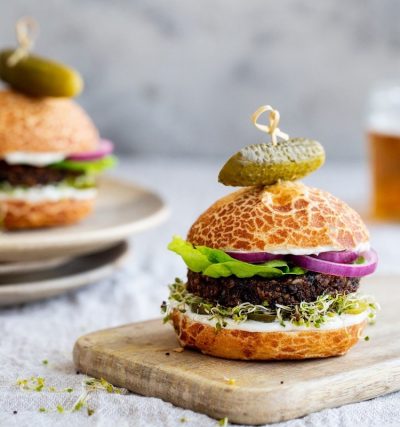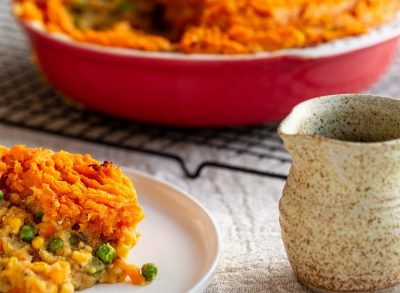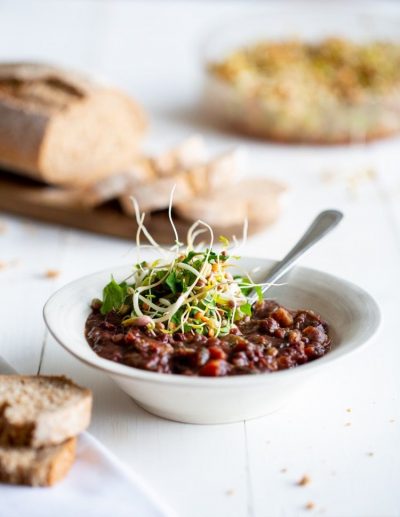Peach Kanten with Sweet Date Cream

Kanten is a Japanese dessert that is somewhat likened to jelly or Jell-O. It is made with agar-agar, a gelatinous substance that comes from several species of dried seaweeds. It’s a classic macrobiotic dessert. Deliciously simple, and simply delicious, this healthy dessert is also packed with the natural fibre in agar flakes.
Kanten
6 sweet ripe peaches
3 medjool dates, pits removed
1 cup apple juice
3 tbsp agar flakes
Pinch sea salt
Topping
Sweet date cream
Fresh blueberries
Sprig fresh mint for garnish
Sweet date cream
½ cup cashews, soaked overnight
6 tbsp almond milk or filtered water
3 medjool dates, pitted
¼ tsp lemon juice
¼ tsp vanilla
Drain the cashews and place all the ingredients for the cream in a high-speed blender. Blend until creamy. You may have to stop and scrape down the sides of the blender with a spatula a few times. Add more liquid to reach the desired consistency.
To remove the skins of the peaches easily, soak them in boiling filtered water for 30 seconds then transfer to an ice bath. Remove the skins and stones from the peaches and transfer the flesh to a blender. When blended you will have around 3 cups of puréed peaches. Add the dates to the blender.
In a small saucepan bring the apple juice, agar flakes and sea salt to a boil. Reduce the heat to low and simmer for 5 minutes stirring occasionally. Pour into the blender and blend to a creamy consistency. Divide into individual serving dishes and chill in the fridge to set. Top with some sweet date cream and fresh berries. Garnish with a sprig of fresh mint. Makes 4–6 servings. Note – This delicious kanten can be made using many other seasonal fruits watermelon, strawberries, etc. – use a quantity that will give you 3 cups of puréed fruit.
Disclaimer
The Human Ecology Project offers health, and nutritional information and is designed for educational purposes only.
You should not rely on this information as a substitute for, nor does it replace, professional medical advice, diagnosis, or treatment.
Gingered Apple Sauce with Cashew Cream and Crunchy Granola

Apple sauce can be made with peeled apples and a variety of spices. Flavourings or sweeteners such as rice syrup or cinnamon are also commonly added. It’s our absolute favourite dessert, straight from my jars. The sauce is equally delicious without the cream and I have been known to eat it straight from the jar.
For the apple sauce
- 4 organic apples
- 2 tbsp apple juice
- Pinch of sea salt
- 1 tsp freshly squeezed ginger juice
Toppings
- Cashew cream
- Granola
- Fresh apple slices
For the cashew cream
- 1 cup cashews, soaked overnight
- Filtered water
- 2 medjool dates
- ½ tsp vanilla extract
Drain the cashews and rinse with cold water. Transfer to a blender and add the dates and vanilla extract. Pour in half a cup of cold filtered water. Blend on high for 2 to 3 minutes, until very smooth and creamy. Add more water if necessary. Cover and refrigerate until ready to use. The cream will thicken as it sits.
Wash and peel the fruit, remove the cores and slice them into bite-sized chunks. Place in a pot with a little filtered water or apple juice and add a pinch of sea salt. Simmer covered on a very low heat until the fruit is soft. When the apples are cooked, either mash with a potato masher or blend to a cream with an upright or stick blender. Stir in the fresh ginger juice and serve this delicious and easy dessert topped with some cashew cream, crunchy granola and a slice of apple. Makes 8 servings.
Note: I make my own granola but for quickness you can purchase granola from your natural food store. Read the labels and look for a brand that does not add sugars.
Oatmeal Walnut Cookies

These are a really wholesome treat, lower in fat and sugar than most shop-bought biscuits and packed with oatmeal and raisins for extra nutrients and flavour. Many of my cookies incorporate fruit and spices, rather than extra sugar and fat. I decided to share this recipe as it is Bill’s absolute favourite.
Ingredients
- 1½ cups oatmeal
- ¾ cup wholewheat pastry flour
- ¾ cup unbleached white flour or almond flour
- 1 tsp baking powder
- ¼ tsp sea salt
- ¾ cup currants
- 1 cup walnuts, toasted and coarsely chopped
- 2 tbsp apple spread
- ½ cup barley malt or brown rice syrup
- Zest of 1 orange
- ½ cup orange juice
- 1 tbsp finely grated fresh ginger juice
- 1 tsp vanilla
Instructions
Preheat the oven to 180°C (350°F), gas 4. Line two baking trays with parchment paper.
In a large bowl, mix the dry ingredients. In a smaller bowl, whisk together the wet ingredients and then stir into the dry ingredients.
Transfer heaping tablespoons of dough to the baking sheet, leaving at least 1 inch (2 cm) of space between the cookies.
Flatten the cookies with the back of a fork to make rounds. Dip the fork in water to keep the mixture from sticking.
Bake the cookies until the edges and undersides are golden, 25 to 30 minutes. Remove from the oven and allow to cool on a rack. Makes 16–18 cookies.
Teriyaki Black Bean Burgers

Vegan burgers can be made with chickpeas, black beans, white beans, potatoes, lentils and pretty much any other vegetable that can be mashed and formed into a burger.
Ingredients
- 2 cups cooked black beans or mixed beans
- 1 cup cooked short-grain brown rice
- 1 cup silken tofu
- 2 heaped tbsp mild salsa
- 1 tbsp umami paste with ginger
- 1 tbsp lime zest
- 1 red onion, chopped
- 2–3 garlic cloves, minced
- 1 tsp ground coriander
- 1 tsp dried oregano
- 1 tsp smoked paprika, optional
- 2 tbsp teriyaki sauce
- 1 tbsp tamari
- ½ cup fresh coriander, minced
- 1 cup sourdough breadcrumbs
I served the burgers in a warm toasted sourdough bun spread with vegan mayo, salad leaves, thinly sliced red onion and alfalfa sprouts. I then topped with a dill pickle. Delicious and filling feast with or without a large green salad.
Note – For kids I would suggest using regular paprika – no spices.
Instructions
Preheat the oven to 180° (350°), gas 4. Line two baking trays with parchment paper.
In a large bowl, mash the beans with a fork or potato masher. Add the cooked rice, tofu, salsa, umeboshi paste and lime zest, and mix well.
Warm a splash or two of filtered water in a small pan and sauté the red onion, garlic, dried herbs, paprika and teriyaki for 5–7 minutes.
Add this mixture to the bowl and stir to combine. Fold in the fresh coriander and breadcrumbs.
Take a heaped tablespoon of the mixture and squeeze together with your hands to form a burger. If not cohesive enough, add some more breadcrumbs.
Place on the baking trays and cook the burgers in the middle of the oven for 25 minutes, turning once halfway through.
Makes 8 good-sized burgers. Double or triple the quantities and freeze for quick lunch/dinner options.
Vegan Shepherd's Pie

In this vegan shepherd’s pie, vegetables and lentils mingle in a sumptuous broth beneath a crown of mashed sweet potatoes. This vegan dish takes on the classic family comfort food and will be loved by all. Use white potatoes instead of sweet potatoes if that is your preference. Serve with a large delicious bowl of salad packed with fresh spring greens, or if cooler weather, delicious with some roasted vegetables.
As we say in Scotland, “Ne'er cast a clout till May is oot,” translation.... keep your coat at the ready until the end of May! The proverb basically reminds us of our fickle weather and its ability to bathe us in warmth one day and bring chilly winds the next. It is an old saying but still a very apt one.
Ingredients
- 4 large sweet potatoes, peeled and cubed
- 1 tbsp paprika
- 1 tbsp dried parsley
- 1 large red onion, chopped
- 2 cloves garlic, crushed
- 2 cups carrots, diced small
- 2 cups organic sweetcorn
- 1 sachet umami instant stock dissolved in 4 cups boiling filtered water
- 2 cups red lentils
- 1 tsp each of thyme, marjoram, basil
- 2 cups sweet garden peas
- 1 tsp black pepper (optional)
- 1 tbsp tamari
Instructions
Preheat the oven to 180°C (350°F), gas 4. Boil the sweet potatoes until soft, drain, transfer to a large bowl and mash with a fork. Stir in the paprika and parsley and set aside.
In a heavy-based pan, sauté the onion, garlic and carrots, along with the sweetcorn, in a little filtered water until tender, about 7 minutes. Set aside. Place the lentils and umami stock into a pot. Bring to a boil and simmer until soft, about 20 minutes. Add the cooked vegetable mixture, along with the herbs, sweet garden peas and black pepper, if using. Add the tamari and mix well. If the mixture is too wet, add in some of the sweet potato mash to thicken.
Fill the bottom of a large casserole dish or small individual pie dishes with the lentil and vegetable mixture, and top with the mashed sweet potatoes. Place on a baking tray to catch any overspill. Cook in the middle of the oven for 25–30 minutes. You may also grill for 5 minutes at the end of cooking to crisp up the sweet potato. Serve smothered in a delicious mushroom gravy. Makes 6–8 servings.
Nest of Steamed Kale with Pressed Salad & Sweet Vinaigrette

Steamed Kale
Remove the leaves and discard the fibrous stem or save for making vegetable stock.
Tear the leaves into pieces and place in a steamer basket/pot.
Bring a small amount of water to a boil, once boiling pop on the steamer basket and steam 4 or 5 minutes until vibrant green.
Pressed Salad with Sweet Vinaigrette
- 1 cucumber, sliced into thin rounds
- 2 cups red radish, sliced into thin rounds
- ¼ teaspoon sea salt
- Sweet Vinaigrette
- ¼ cup brown rice vinegar
- ¼ cup mirin
- Pinch sea salt
- 1 tbsp. toasted white sesame seeds
Instructions
Place the vegetables and sea salt in a small bowl and mix. If you don’t have a pickle press keep the vegetables in the bowl and put a weight on a plate and place directly on the vegetables.
Allow to sit for at least one hour.
Squeeze any excess liquid from the salad by gently squeezing the vegetables.
Toss with the dressing and sprinkle with toasted white sesame seeds.
Roasted Vegetable Combo

What vegetables to roast? Root vegetables like potatoes, parsnips, sweet potatoes and carrots are old standbys when it comes to roasting, of course, but there are all sorts of wonderful concoctions you can come up with. From cruciferous vegetables like broccoli and Brussels sprouts to courgettes, onions and bell peppers. I often make a batch of oven-roasted root vegetables and store leftovers for the next day’s lunch.
- Ingredients
- 2 parsnips, peeled and thickly sliced
- 2 large red beetroots, scrubbed, peeled and quartered
- 2 large carrots, cut into thick spears
- 1 large sweet potato, cut into thick spears
- 2 large red onions, peeled and thickly sliced
- 1 courgette, cut into irregular chunks
- 6 cloves of garlic, in skins (remove after roasting)
- 2 tbsp balsamic vinegar
- Sea salt and freshly ground pepper
- 1 tbsp mixed herbs
Instructions
Preheat the oven to 180°C (360°F), gas 5.
In a large bowl, toss the vegetables in the balsamic vinegar. Add some sea salt and freshly ground black pepper.
Sprinkle with a spoonful of your favourite herbs: oregano, thyme, rosemary, sage, parsley or basil, and mix well.
Transfer the vegetables to a parchment-lined roasting tin.
Roast the vegetables for about 1 hour, stirring them at least twice through the cooking time. If you prefer your vegetables less cooked, shorten the roasting time.
The balsamic vinegar and sea salt make for fabulous roasting, complementing the caramelised sweetness with a perfect touch of salty-tart.
Makes 4–6 servings.
Adzuki Bean Soup with Tamari and Ginger

Ingredients
- 1 sachet umami instant stock paste
- 1 cup dried adzuki beans-soaked overnight night (yields 3 cups cooked beans) or use canned organic cooked beans
- 3-inch piece kombu seaweed
- 1 cup each of diced onion, carrot, celery, butternut squash, burdock and parsnip
- 4 strips kale, (leaves only) thinly sliced
- Freshly grated ginger juice to taste (approximately 1 tbsp.)
- 1-2 tbsp. tamari
- Finely sliced spring onions for garnish
Instructions
Dissolve the umami stock paste in three cups warm water and set aside. Discard the water from the soaking beans. Place the beans and kombu in a pressure cooker with enough fresh filtered water to cover them and cook for 50 minutes. Allow the pressure to release naturally. Open the pressure cooker and add the stock and all the vegetables except the kale. Cover and cook on low heat for 25 minutes.
If using pre-cooked beans disregard the first part on pressure cooking and simply place the beans, vegetables (except the kale) and stock in a heavy based pan and cook for 25-30 minutes on a low heat or until soft. Stir in the kale and cook for another 5 minutes then add the ginger juice and tamari to taste. Garnish with spring onions.
Human Ecology Nutritional Tip
Azduki beans are small and very compact, with a deep reddish-brown colour. These tiny beans are a staple in the Far East. They are revered in Japan for their healing properties. They are low in fat and reputed to be more digestible than most other beans as well as rich sources of potassium and iron and B Vitamins (not B12) and high in protein and fibre. I use these incredibly power packed nutritional beans to make soups, burgers, medicinal teas and pate’s. The possibilities are endless.
Miso Soup

Ingredients
- 1 small strip kombu seaweed (about 4 inches)
- ¼ cup tightly packed dried maitake mushrooms or 2 dried shiitake mushrooms
- 4 cups filtered water
- 3 spring onions, thinly sliced
- 1 tsp. wakame flakes, or 1 x 5-inch piece wakame (pre-soaked), cut into small pieces
- 4 or 5 heaped tsp. miso paste, (approx.1 tsp. miso per bowl of soup)
- 1 tbsp. freshly grated ginger juice
- Splash or two of tamari
- Diced spring onion or chives and alfalfa sprouts, for garnish
Instructions
Soak the kombu and shiitake or maitake mushrooms in two cups of water for 20 minutes. Remove the mushrooms and cut into small pieces. If using shiitake mushrooms, cut off the stems and discard and thinly slice the caps.
Put the mushrooms and the soaking water in a pot and add another 4 cups of filtered water. Bring to a boil and then cook on low simmer for 10 minutes. Add the spring onions and wakame flakes and cook 5 minutes. Place the miso paste into a small mesh strainer and lower into the broth, using a spoon stir until the paste is dissolved and then scrape in the residue (grain) into the soup pot. Add the ginger juice to aid in digestion and facilitate the cells' uptakes of sugars.
Tip: do not boil the miso – it has so many living microorganisms which is a wonderful digestive tonic. You can make a larger batch, store in glass container in the refrigerator and take required amount each morning and gently warm.
Note
Miso is a fermented soybean paste used to flavour various dishes, but most widely used as a stock to season soups. Miso’s natural fermentation process creates a combination of enzymes that strengthen and nourish the intestinal tract. As a result, the blood that nourishes the balance of the body is much stronger. The quality of our blood creates the people we are, and the health we possess. This basic miso soup should be a daily staple of your diet. It encompasses the use of sea vegetables to mineralize the blood and a variety of fresh vegetables. The balance of these ingredients creates a strengthening energy vital to life. Miso has been used for centuries in the Orient as a remedy for cancer, weak digestion, low libido several types of intestinal infections, lowering cholesterol, and so much more and is one of the world’s most medicinal foods.

